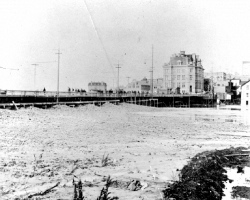Welcome to the Empress Hotel
Timeline
June 1901::Over a thousand ratepayers voted in favour of a bylaw to have the James Bay mudflats filled in.
February 1901::Victoria's own Francis
Rattenbury was selected as the architect for CPR's western division.
27 November 1901::With the dam holding
back the waters of the inner harbour complete, the mudflats began their
transformation into land.
24 August 1903::The city and the Canadian
Pacific Railway reached
an agreement to construct a "first class modern hotel."1
19 September 1904::Work finally
began on the very unique foundation for the hotel.
19 September 1905::The CPR's future hotel in Victoria finally received its name; the Empress.
20 January 1908:: A gentleman's luncheon was held to mark the official opening of the Empress.
Shifty ground
 The James Bay Bridge
The James Bay Bridge
Before Victoria's population explosion in the late 1880's, the mudflats bordering the inner harbour were relatively harmless and useless. Yet as increasing numbers of Victorians dumped all of their refuse into the ocean, the mudflats transformed into a "stinking tidal garbage dump."2 The harbour landfill was not only unsightly for Victoria's citizens, but it was also hazardous to their health. By 1901 it was finally decided that the mud flats would be done away with for good, and doing so required approximately 300,000 tons of fill.3 In order to tempt the Canadian Pacific Railway into building their newest luxury hotel on the newly reclaimed mudflats rather than on other possible locations in Victoria, the city was willing to offer the land as a gift. Eager to seal the deal, the city ended up having to bargain heavily in favour of CPR president Sir Thomas Shaughnessy. He demanded exemptions from taxation, free water for 20 years, and of course the free parcel of land itself.4
And the dam held
 Constructing the causeway
Constructing the causeway
By November 1903 the retaining wall holding back the tide that normally covered the mudflats was weakening and near the point of giving way. Although this fault was immediately corrected, thus eliminating the threat of disaster, it alarmed the CPR's newest chief engineer William Tye a great deal. His concern was for the soft fill the Empress was about to be constructed on top of, which could potentially give out at any time. In order for the Empress to safely use the mudflats as its location, its foundation had to be based on 50 foot long pilings that could reach the blue clay base beneath the flats. 5
Construction concerns
 The fill
The fill
As plans for the Empress continued to change, costs continuously rose from the original estimations and money saving choices had to be made. The Colonist, one of Victoria's newspapers, complained that the change from stone to brick for the Empress's facing meant that money planned to be spent on locally dressed stone would be sent abroad to pressed brick manufacturers.6 This was an effective cut down on cost for the CPR because brick was considerably cheaper than stone. However this decision would cut into the promised provision of local work, which had induced Victorians to support the plans for the hotel's construction. Luckily, the actual contract to supply the 2,750,000 bricks was awarded to local brickmaker Humber & Sons, bringing the Empress back into favour with Victorians.7
What's in a name?
 The Empress near completion
The Empress near completion
Up until its christening, the Empress had no definitive identity other than the "Victoria hotel" or the "CPR tourist hotel." Several names were suggested for the majestic hotel being built before Victoria's eyes. Some of them included the "Douglas Arms," the "Royal Oak," the "Camosun," the "Carnavon," the "Dufferin," and the "Lytton."8Notably, even the name "Lotbiniere" was suggested in honour of the current lieutenant governor Sir Henri Joli de Lotbiniere. Once the "Empress" was decided upon, its superiority to the other suggestions was visible because of its connotations of Queen Victoria, the Empress of India, as well as the CPR's Empress liners. Though not intentionally, the name "Empress" also acted as a negative reminder of Victoria's imperialist roots, and of the continued colonial presence on First Nations' land.
A symbol of the city
 Adding the finishing touches
Adding the finishing touches
The Empress was initially designed for the benefit of wealthy tourists, with whom local Victorians would not be encouraged to mingle with since they would be limited to using the Grill room and Billiard room only. However, instead of being rejected by Victorians, the Empress was embraced. Within a few days of its opening, the Empress established a businessmen's lunch, and arranged a small orchestra to entertain ladies for afternoon tea.9 The Empress achieved the desired effect of putting Victoria on the map as a luxury tourist destination, bringing a new bolster for the economy with it. Today the Empress continues its tradition of encouraging Victorians to treat the hotel as their own by hosting various dinners and dances for the yearly graduating classes. Tourists worldwide associate the Empress as a symbol of Victoria and vice versa.
1 Terry Reksten, The Empress Hotel: In the Grand Style (Vancouver and Toronto: Douglas & McIntyre, Ltd., 1997), 20.